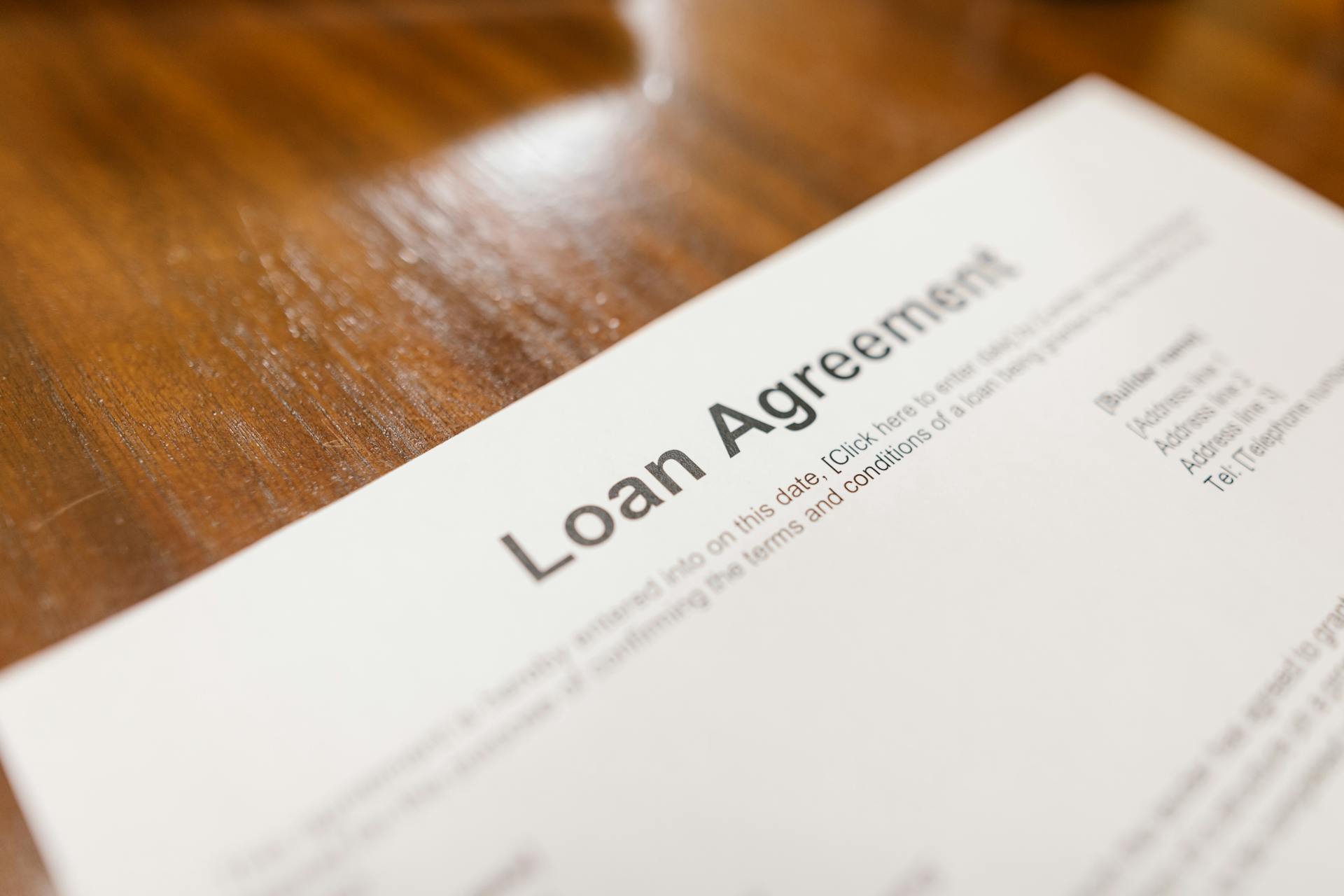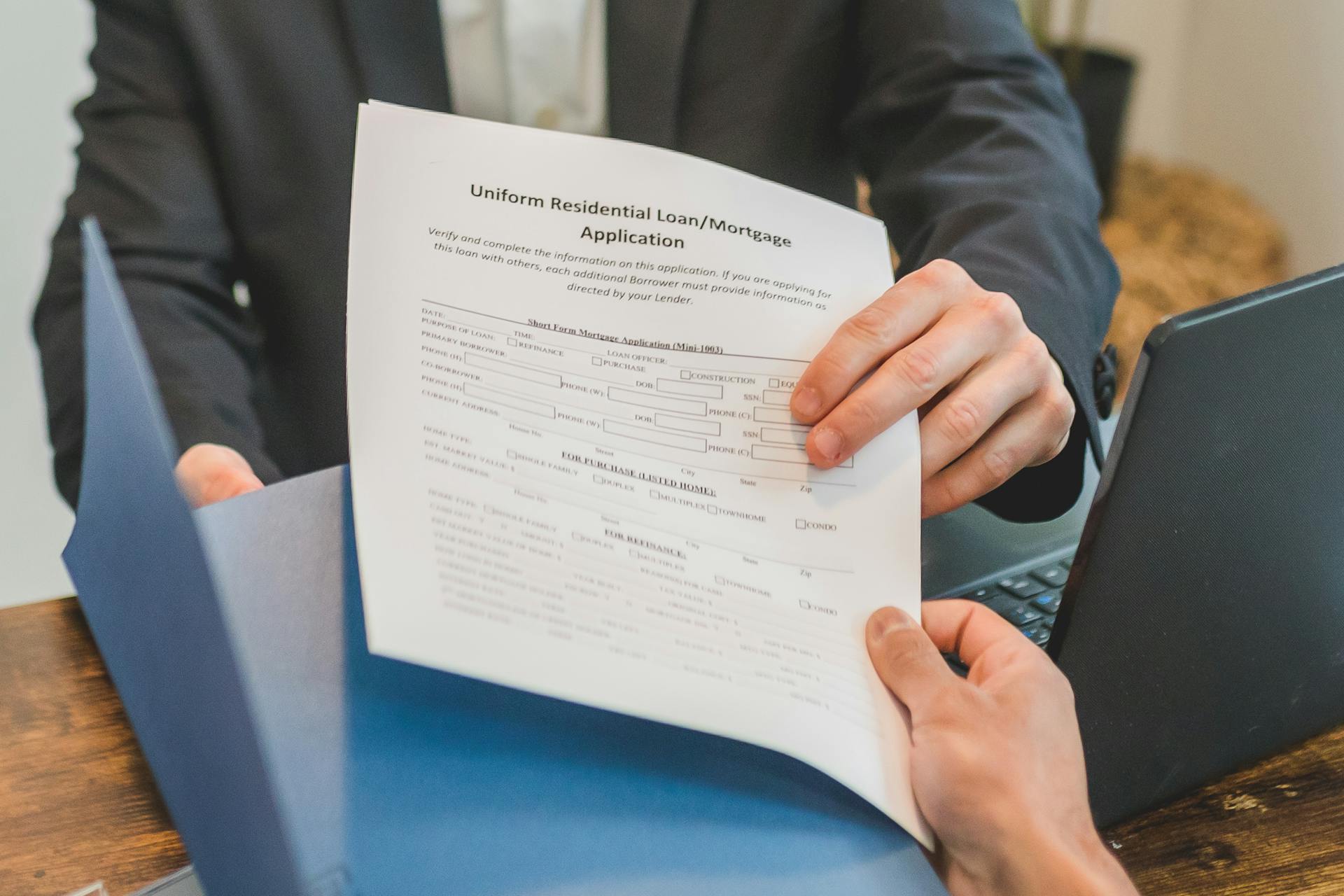
Convertible loan agreements can be a game-changer for startups, providing a flexible source of funding that can be converted into equity at a later stage.
This type of agreement allows investors to lend money to a startup without immediately requiring ownership or control.
Convertible loan agreements usually have a conversion price, which is the price at which the loan can be converted into equity.
The conversion price is often tied to the startup's valuation at the time of conversion, and can be a fixed price or a formula-based price.
Startups should carefully consider the conversion price and the terms of the agreement to ensure they are fair and reasonable.
The agreement may also specify a conversion event, which is a trigger that sets off the conversion process.
A common conversion event is a future funding round, where the startup raises additional capital and the loan is automatically converted into equity.
Curious to learn more? Check out: Jumpstart Our Business Startups Act
What Is a Convertible Loan Agreement?
A convertible loan agreement is a financing tool that offers flexibility to both investors and companies. It allows investors to choose between retaining a loan or converting it into shares, depending on the company's future developments.
This type of agreement offers several benefits, including flexibility for both parties, funding opportunities for emerging companies, lower interest costs, and the opportunity for growth without immediate share issuance. Companies can attract capital without immediately issuing shares, giving them the opportunity to grow and improve their company's valuation before issuing shares to investors.
Startups often use convertible loan agreements to quickly obtain capital, which they can use for seed funding or to extend their runway between financing rounds. However, this quick access to capital comes at a certain cost of capital, as the company takes on debt that may need to be repaid.
Take a look at this: Creative Financing for Business Purchase
Startups Secure Capital, Reducing Investor Risk
Startups can quickly obtain capital with a convertible loan, accessing funds faster than with other financing sources. This is especially true for seed funding, which helps startups make necessary investments and boost growth.
Discover more: Business Credit Lines for Startups
A convertible loan can be used between financing rounds to extend a startup's runway, giving them time to reach the next round and secure fresh capital. This is a common practice among startups.
The quick access to capital comes with a cost, however. Startups take on debt that they theoretically need to repay, and if debt is converted into equity, investors acquire company shares at a lower price than new investors.
Investors with a convertible loan mitigate their risk by providing debt capital with a fixed term, interest, and repayment rates. This makes the risk more manageable than with an equity investment.
Here are some benefits of convertible loans for startups and investors:
- Flexibility for both investors and companies
- Funding source for emerging companies
- Lower interest costs
- Opportunity for growth without immediate share issuance
Bonds
Bonds are a type of debt instrument that companies use to raise capital. They represent a debt of the issuing entity to investors.
Bonds typically involve interest payments throughout the loan term. This is similar to Convertible Loan Agreements, which also may include interest payments.
Companies use bonds to finance their operations, providing a way to raise capital from investors. This is one of the key similarities between bonds and Convertible Loan Agreements.
Here's a comparison of the two:
Understanding the differences between bonds and Convertible Loan Agreements is essential for companies to make informed financing decisions.
Characteristics and Benefits
Convertible loans offer a range of benefits for companies, including quick access to capital and a flexible contract structure. This allows companies to focus on growth without being bogged down by complex loan agreements.
One of the key advantages of convertible loans is that they don't have a significant impact on a company's cash flow, as interest and repayment typically occur at the end of the term. This means companies can manage their finances more effectively.
Companies can also benefit from a credit line increase, as banks view convertible loans as "equity-like." This can provide a safety net for companies that need additional funding in the future.
Here are some of the key characteristics of convertible loans:
- Flexible and uncomplicated contract structure.
- Low costs associated with contract drafting.
- Repayment and interest typically occur at the end of the term.
- Lenders do not have voting rights in the company until conversion.
Flexible

Convertible loans are known for their flexibility, which is a major advantage for companies and investors alike. This flexibility allows for a range of repayment options, including repayment at the end of the term, interest-free periods, and flexible conversion discounts.
One key benefit of convertible loans is that they offer quick access to capital, which can be a lifesaver for companies in need of funding. The contract structure is also relatively uncomplicated, which can save companies a lot of time and money on contract drafting.
The conversion discount and valuation cap offer investors additional incentives, allowing them to acquire shares at a lower price than future investors. This can be a major motivator for investors, especially if they believe in the company's potential for growth.
Here are some key flexible features of convertible loans:
- Repayment at the end of the term
- Interest-free period
- Height of the conversion discount
- Valuation Cap
These flexible features can be tailored to suit the needs of the parties involved, making convertible loans relatively flexible. This alignment of interests between startups and investors can be a major advantage in the world of finance.
Core Features of Spanish Non-Listed Companies

Spanish non-listed companies offer a unique set of features that set them apart from their listed counterparts. These companies are not required to disclose financial information to the public, which can be beneficial for companies that prefer to maintain their financial data private.
One of the key features of Spanish non-listed companies is their flexibility in terms of ownership structure. They can be owned by a single individual, a group of individuals, or even a family. This flexibility allows companies to maintain control and make decisions without external influence.
Spanish non-listed companies can also choose to limit the number of shareholders, which can be beneficial for small businesses or family-owned companies. This limited ownership structure can help maintain family control and prevent external investors from taking control of the company.
The lack of public disclosure requirements for Spanish non-listed companies can be beneficial for companies that are in the early stages of development or have sensitive financial information. This can help them maintain a competitive edge and avoid public scrutiny.
A different take: The Purpose of Is to Transfer Financial Risk
Agreement Process
The agreement process for a convertible loan is a crucial step in securing funding for your business.
The agreement typically begins with the negotiation of the terms, including the conversion price, interest rate, and repayment terms.
A convertible loan agreement can be tailored to meet the specific needs of both parties, allowing for flexibility in the terms.
The agreement will specify the conditions under which the loan can be converted into equity, such as a certain milestone being reached or a specified amount of funding being raised.
The conversion price is a critical component of the agreement, as it determines the value of the equity that the lender will receive.
The agreement may also include provisions for the repayment of the loan, such as a repayment schedule or a payment of principal and interest.
The loan agreement should clearly outline the rights and responsibilities of both parties, including the lender's right to convert the loan and the borrower's obligation to repay the loan.
The agreement process can be complex and time-consuming, requiring careful consideration of the terms and conditions.
Intriguing read: Direct Cash Advance Lenders
Valuation and Conversion
Valuation and Conversion is a crucial aspect of a convertible loan agreement. The valuation discount determines the discount that investors receive on the shares, typically ranging between 20 to 30%. This means they pay less per share than new investors.
The valuation cap is the maximum company valuation at which debt capital converts into equity. For instance, if the convertible loan providers set the Valuation Cap at €5 million, but the startup is valued at €10 million in the next financing round, the convertible loan providers will convert at the predetermined valuation of €5 million.
A positive valuation shows that current assets can cover current liabilities, which is important in terms of the golden rule of the balance sheet. A negative value conveys a risk, because affected companies are considered to be illiquid.
The valuation discount and Valuation Cap typically do not apply together. The parties contractually agree in advance that the convertible loan providers must choose one of the two instruments at the time of conversion.
Recommended read: 5 Billion Yen

Here's a summary of the key elements of valuation and conversion:
- Whether it is a right or obligation for the investors.
- The formula for calculating the shares investors receive.
- Information about the valuation discount and valuation cap.
- A mechanism to secure the conversion, which may involve commitments from the company or the founders or management.
In a convertible loan with a valuation discount, the investor offers funding through a loan with a 20% valuation discount, applicable during the next financing round. The formula to calculate the shares is: €108,000 / €39 per share = 2,769 shares for the convertible loan provider.
A convertible loan with a valuation cap has a Valuation Cap of €3 million, and the formula to calculate the shares is: €108,000 / €29 per share = 3,724 shares for the convertible loan provider. This scenario can serve as an incentive for investors to participate in a startup as early as possible and take on the additional risk.
Related reading: Llc Share Certificate
Pros and Cons
A convertible loan agreement offers several benefits to companies in need of financing. Quick access to capital is one of the main advantages, allowing startups to bridge financing gaps between funding rounds and fuel their growth.
Curious to learn more? Check out: Med Spa Equipment Financing

Flexible and uncomplicated contract structures are another benefit, making it easier for companies to secure funding without the complexities associated with traditional equity investments.
Interest and repayment typically occur at the end of the term, minimizing the impact on the company's cash flow.
Here are some of the key benefits of convertible loans for companies:
Lenders do not have voting rights in the company until conversion, giving companies more control over their business decisions.
Smaller Financing Amounts
Smaller financing amounts are a common reality for startups, especially in the early stages. Funding amounts typically range from €100,000 to €500,000.
This range makes it possible for startups to finance themselves with several convertible loans, each for smaller amounts. In fact, the granting of million-euro amounts is rather rare with convertible loans in the early stages of a startup.
This flexibility is one of the benefits of convertible loans, allowing startups to access the funding they need without being tied to a specific valuation.
Shareholder Resolution

A shareholder resolution is required to enter into a convertible loan agreement, which typically needs a simple majority in the shareholders' meeting.
In the case of a startup, the shareholders' meeting is usually composed of the founders, making decision-making relatively straightforward.
To pass a shareholder resolution, the founders must agree on the terms of the convertible loan agreement.
This process can be a great opportunity for founders to work together and come to a unified decision.
Pros and Cons of a Loan Agreement
A loan agreement can be a lifesaver for those in need of immediate cash, but it's essential to consider the pros and cons before signing on the dotted line.
One major advantage of a loan agreement is that it provides access to funds for unexpected expenses or financial emergencies, such as medical bills or car repairs.
A loan can also be used to finance large purchases, like a new home or a business venture, allowing you to spread the cost over time.

However, loan agreements often come with high interest rates, which can quickly add up and make it difficult to pay back the loan.
For example, a loan with a 10% interest rate can result in paying back twice the initial amount borrowed over a 5-year period.
Additionally, loan agreements may require collateral, which can put your assets at risk if you're unable to make payments.
On the other hand, a loan agreement can also help you build credit, as regular payments can improve your credit score over time.
This can be especially beneficial if you're planning to apply for a mortgage or other large loan in the future.
Ultimately, it's crucial to carefully weigh the pros and cons of a loan agreement before making a decision that's right for you.
You might like: Do I Have to Pay Back a Subsidized Loan
Challenges of Companies
Companies that take on convertible loans need to be aware of the challenges that come with this type of funding.
Convertible loan lenders can be tough negotiators, often requiring a high discount on the company's next valuation, typically 20 to 30%.

A company's valuation cap can result in capital providers acquiring more shares at an even lower price, which can be a blow to the company's equity.
If a company doesn't meet its funding round or milestone targets, investors may not benefit from conversion, leaving them with a worthless loan.
Until conversion, investors have limited control over company decisions, unlike equity shareholders who have a say in the company's direction.
Expand your knowledge: Angel Investors for Small Business
Differences Between Bonds
Convertible Loan Agreements and bonds share some similarities, but they also have key differences.
One major difference is the conversion option into shares, which is not available in bonds. This means that investors in bonds don't have the same flexibility as those in Convertible Loan Agreements.
Interest payments in bonds are fixed, whereas in Convertible Loan Agreements, these payments can sometimes be converted into shares. This can be a more attractive option for investors who want to diversify their investment portfolio.
Here's an interesting read: Jim Cramer Shares His Hottest Stock Picks.

Bonds have a fixed maturity date, which means the issuer must repay the principal amount on a specific date. In contrast, Convertible Loan Agreements don't have a strict maturity date, allowing investors to convert their loan into shares without a specific time limit.
Here's a quick comparison of the two:
Implementation and Execution
To implement a convertible loan agreement, it's essential to seek legal advice to ensure all aspects and conditions are correctly documented.
Establishing clear terms is crucial, including the conversion price, interest rates, term, and conversion date, which must be agreed upon by all parties involved.
Once the agreement is drafted and signed, all parties must adhere to the established terms and monitor the term to ensure successful execution.
Monitoring the term and fulfilling the agreements are crucial for the successful execution of the convertible loan.
Here are the key steps to complete the process:
- Legal advice and documentation
- Establishing terms
- Execution and monitoring
Subordination
Subordination is a key concept to understand when it comes to convertible loans. The repayment claim of convertible loan lenders is placed at the very end of the list of creditors in the event of insolvency.
This is because investor claims are treated as equity, not considered a liability of the company.
Implementing

Implementing a convertible loan agreement requires careful planning and agreement between parties. The process involves seeking legal advice and documentation to ensure all aspects and conditions are correctly documented.
To complete this process, you'll need to establish the terms of the loan, including the conversion price, interest rates, term, and conversion date. These terms must be clearly established and agreed upon by all parties involved.
Here are the key steps to consider:
- Legal advice and documentation: This is essential to ensure all aspects and conditions are correctly documented.
- Establishing terms: The terms of the loan, such as the conversion price, interest rates, term, and conversion date, must be clearly established and agreed upon by all parties involved.
- Execution and monitoring: Once the agreement is drafted and signed, all parties must adhere to the established terms.
The involved parties require only minimal information to make a decision, making convertible loans a relatively quick-to-implement financial instrument.
Check this out: Venture X Dallas - Braniff Centre
Conversion and Interest
Conversion and interest are closely tied in a convertible loan agreement. A positive conversion value shows that current assets can cover current liabilities, which is crucial for a company's financial health.
The conditions for conversion are key, including whether it's a right or obligation for investors, and the formula used to calculate the shares they receive. A valuation discount and valuation cap can also impact the conversion process.
The conversion process can be secured through commitments from the company, founders, or management. This provides a mechanism to ensure the conversion takes place as planned.
Here are the key elements of conversion:
- Right or obligation for investors
- Formula for calculating shares
- Valuation discount and cap
- Securing mechanism
Final Conversion
The final conversion is a crucial step in the process of convertible loans. It's when the former investors become shareholders of the startup, and the calculations for the valuation discount or valuation cap come into play.
The valuation cap serves as a protection mechanism for the investor, guaranteeing the limit up to which they accept to be diluted in the next investment round. This can be as high as 30% of the valuation.
A conversion can be automatic, regardless of the investor's approval, or optional, depending on the investor's consent. This means that the conversion doesn't depend on the company's will.
The minimum amount for a qualified investment round can vary greatly depending on the context of the company. It's often defined as guaranteeing investors that they'll only lose their redemption right if the company demonstrates its operational viability and ability to finance itself adequately.
A valuation represents the "fair" value of the company through an agreement between the parties on the investment date. This is often used in conjunction with a valuation cap and discount to determine the final conversion price.
The discount is a percentage applied to the valuation of the qualifying round, usually between 10% to 30%. This is an incentive to the investor, rewarding them for the additional risk they took by investing earlier in the business.
Here's an interesting read: Net 30 Credit Cards
Conversion:
Conversion is a crucial aspect of convertible loan agreements, where debt can be converted into equity or a company shareholding. This process is not automatic, but rather depends on the occurrence of some event, such as expiration or completion of a qualifying round.
The conversion may be automatic, regardless of the investor's approval, or optional, depending on the investor's consent. In both cases, the conversion does not depend on the company's will.
A valuation cap is an incentive to the investor, serving as a protection mechanism that guarantees the limit up to which it accepts to be diluted in the next investment round. The valuation cap can be a percentage of the company's valuation.
The discount is another incentive to the investor, a percentage applied to the valuation of the qualifying round that guarantees the investor better conditions for new investors. The discount is usually 10% to 30%.
Here are some key elements of the conversion process:
- Whether it is a right or obligation for the investors.
- The formula for calculating the shares investors receive.
- Information about the valuation discount and valuation cap.
- A mechanism to secure the conversion, which may involve commitments from the company or the founders or management.
The valuation represents the "fair" value of the company through an agreement between the parties on the investment date. This allows for a range of terms to be opened, including the qualified investment round, valuation cap, and discount.
For more insights, see: Aswath Damodaran Valuation Book
Interest and Restatement
Interest and restatement are key aspects of conversion that can impact the borrower and lender.
Interest rates are usually low, aiming only to ensure that the credit does not depreciate over time.
The conversion of interest may imply an additional discount on the valuation of the round due to the payment of the tax income by the investor.
Payment is made in shares according to the valuation or mathematical formula originally negotiated between the parties when the borrower owes the payment.
A longer-term is more beneficial to the company as it guarantees a long period for improvement and ensures the transformation into a corporation will occur at the right time.
Worth a look: Aswath Damodaran Valuation
Conclusion: Dynamic Financing Instrument
A convertible loan agreement can be a dynamic financing instrument for businesses, offering flexibility and growth potential.
By converting debt into equity, companies can avoid the stigma of debt and attract new investors.
The conversion feature can be triggered by various events, such as a merger or acquisition, as seen in the example of ABC Corporation.

This flexibility allows businesses to adapt to changing market conditions and pursue new opportunities.
A convertible loan agreement can be structured to include features such as a fixed conversion price, as illustrated in the example of XYZ Inc.
This can provide a clear understanding of the conversion terms and avoid disputes with investors.
The key to a successful convertible loan agreement is to strike a balance between the interests of the lender and the borrower, as seen in the example of DEF Venture Capital.
By understanding the conversion features and terms, businesses can make informed decisions and navigate the complexities of convertible financing.
Related reading: Payment Terms and Conditions
Frequently Asked Questions
What is the difference between a convertible bond and a convertible loan?
A convertible bond has a fixed maturity date for repayment, whereas a convertible loan allows for flexible conversion into shares without a strict repayment deadline. This key difference affects how investors can access their returns.
What is the maturity date of a convertible loan agreement?
The maturity date of a convertible loan agreement is the point in time when the company must repay the loan, typically ranging from 9 to 36 months after the agreement is signed. This date marks the end of the loan term, unless the loan is converted into equity beforehand.
Sources
- https://www.re-cap.com/financing-instruments/convertible-loan
- https://sharecouncil.co/en/blog/what-are-convertible-loan-agreements-and-what-are-their-benefits
- https://sharecouncil.co/en/blog/convertible-loan-agreements-vs-bonds
- https://www.caseslacambra.com/article-convertible-loans-key-features-granted-to-spanish-non-listed-companies-key-features/
- https://camposthomaz.com/en/conhecimento-ct/convertible-loan/
Featured Images: pexels.com


